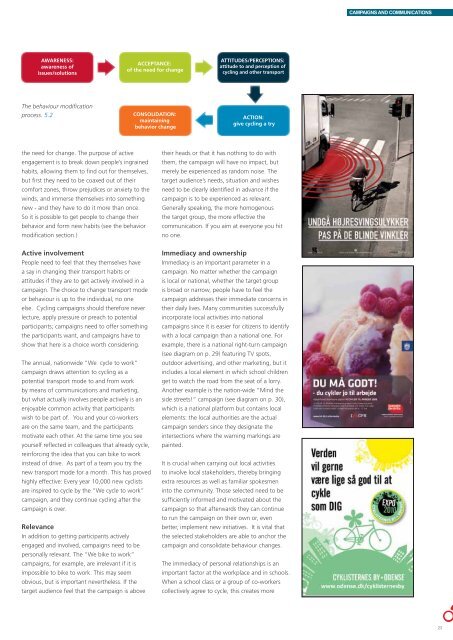Collection of Cycle Concepts 2012.pdf - Fietsberaad
Collection of Cycle Concepts 2012.pdf - Fietsberaad
Collection of Cycle Concepts 2012.pdf - Fietsberaad
Create successful ePaper yourself
Turn your PDF publications into a flip-book with our unique Google optimized e-Paper software.
CAMPAIGNS AND COMMUNICATIONS<br />
AWARENESS:<br />
awareness <strong>of</strong><br />
issues/solutions<br />
ACCEPTANCE:<br />
<strong>of</strong> the need for change<br />
ATTITUDES/PERCEPTIONS:<br />
attitude to and perception <strong>of</strong><br />
cycling and other transport<br />
The behaviour modification<br />
process. 5.2<br />
CONSOLIDATION:<br />
maintaining<br />
behavior change<br />
ACTION:<br />
give cycling a try<br />
the need for change. The purpose <strong>of</strong> active<br />
engagement is to break down people’s ingrained<br />
habits, allowing them to find out for themselves,<br />
but first they need to be coaxed out <strong>of</strong> their<br />
comfort zones, throw prejudices or anxiety to the<br />
winds, and immerse themselves into something<br />
new - and they have to do it more than once.<br />
So it is possible to get people to change their<br />
behavior and form new habits (see the behavior<br />
modification section.)<br />
their heads or that it has nothing to do with<br />
them, the campaign will have no impact, but<br />
merely be experienced as random noise. The<br />
target audience’s needs, situation and wishes<br />
need to be clearly identified in advance if the<br />
campaign is to be experienced as relevant.<br />
Generally speaking, the more homogenous<br />
the target group, the more effective the<br />
communication. If you aim at everyone you hit<br />
no one.<br />
Active involvement<br />
People need to feel that they themselves have<br />
a say in changing their transport habits or<br />
attitudes if they are to get actively involved in a<br />
campaign. The choice to change transport mode<br />
or behaviour is up to the individual, no one<br />
else. Cycling campaigns should therefore never<br />
lecture, apply pressure or preach to potential<br />
participants; campaigns need to <strong>of</strong>fer something<br />
the participants want, and campaigns have to<br />
show that here is a choice worth considering.<br />
The annual, nationwide “We cycle to work”<br />
campaign draws attention to cycling as a<br />
potential transport mode to and from work<br />
by means <strong>of</strong> communications and marketing,<br />
but what actually involves people actively is an<br />
enjoyable common activity that participants<br />
wish to be part <strong>of</strong>. You and your co-workers<br />
are on the same team, and the participants<br />
motivate each other. At the same time you see<br />
yourself reflected in colleagues that already cycle,<br />
reinforcing the idea that you can bike to work<br />
instead <strong>of</strong> drive. As part <strong>of</strong> a team you try the<br />
new transport mode for a month. This has proved<br />
highly effective: Every year 10,000 new cyclists<br />
are inspired to cycle by the “We cycle to work”<br />
campaign, and they continue cycling after the<br />
campaign is over.<br />
Relevance<br />
In addition to getting participants actively<br />
engaged and involved, campaigns need to be<br />
personally relevant. The “We bike to work”<br />
campaigns, for example, are irrelevant if it is<br />
impossible to bike to work. This may seem<br />
obvious, but is important nevertheless. If the<br />
target audience feel that the campaign is above<br />
Immediacy and ownership<br />
Immediacy is an important parameter in a<br />
campaign. No matter whether the campaign<br />
is local or national, whether the target group<br />
is broad or narrow, people have to feel the<br />
campaign addresses their immediate concerns in<br />
their daily lives. Many communities successfully<br />
incorporate local activities into national<br />
campaigns since it is easier for citizens to identify<br />
with a local campaign than a national one. For<br />
example, there is a national right-turn campaign<br />
(see diagram on p. 29) featuring TV spots,<br />
outdoor advertising, and other marketing, but it<br />
includes a local element in which school children<br />
get to watch the road from the seat <strong>of</strong> a lorry.<br />
Another example is the nation-wide “Mind the<br />
side streets!” campaign (see diagram on p. 30),<br />
which is a national platform but contains local<br />
elements: the local authorities are the actual<br />
campaign senders since they designate the<br />
intersections where the warning markings are<br />
painted.<br />
It is crucial when carrying out local activities<br />
to involve local stakeholders, thereby bringing<br />
extra resources as well as familiar spokesmen<br />
into the community. Those selected need to be<br />
sufficiently informed and motivated about the<br />
campaign so that afterwards they can continue<br />
to run the campaign on their own or, even<br />
better, implement new initiatives. It is vital that<br />
the selected stakeholders are able to anchor the<br />
campaign and consolidate behaviour changes.<br />
The immediacy <strong>of</strong> personal relationships is an<br />
important factor at the workplace and in schools.<br />
When a school class or a group <strong>of</strong> co-workers<br />
collectively agree to cycle, this creates more<br />
23



